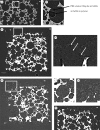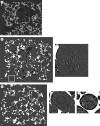The degradation properties of co-continuous calcium phosphate polyester composites: insights with synchrotron micro-computer tomography
- PMID: 20538756
- PMCID: PMC3024571
- DOI: 10.1098/rsif.2010.0014.focus
The degradation properties of co-continuous calcium phosphate polyester composites: insights with synchrotron micro-computer tomography
Abstract
This study investigates the in vitro degradation properties of composites consisting of a porous tricalcium phosphate (TCP) foam filled with degradable poly(dl-lactic acid) (PDLLA) via either in situ polymerization or infiltration. The motivation was to develop a material for bone repair that would be initially mechanically strong and would develop porosity during degradation of one of the components. A thorough analysis of the physical in vitro degradation properties has been conducted and reported by the same authors elsewhere. Synchrotron micro-computer tomography analysis (conducted at ID19, ESRF, Grenoble, France) allowed detailed insights to be gained into the process of the composites' degradation, which was discovered to be strongly influenced by the manufacturing method. The polymer phase of in situ-polymerized TCP-PDLLA degraded as a bulk sample, with faster degradation in the centre of the sample as a whole. In contrast, the polymer phase of infiltrated TCP-PDLLA degraded as individual polymer spheres with faster degradation in the centre of each sphere.
Figures







Similar articles
-
Degradation properties of co-continuous calcium-phosphate-polyester composites.Biomacromolecules. 2009 Jul 13;10(7):1976-85. doi: 10.1021/bm900397d. Epub 2009 Jun 17. Biomacromolecules. 2009. PMID: 21197963
-
[Preparation and degradation of poly(DL-lactide)/calcium phosphates porous scaffolds].Sheng Wu Yi Xue Gong Cheng Xue Za Zhi. 2004 Apr;21(2):174-7. Sheng Wu Yi Xue Gong Cheng Xue Za Zhi. 2004. PMID: 15143533 Chinese.
-
Effect of in vitro degradation of poly(D,L-lactide)/beta-tricalcium composite on its shape-memory properties.J Biomed Mater Res B Appl Biomater. 2008 Jul;86(1):170-80. doi: 10.1002/jbm.b.31003. J Biomed Mater Res B Appl Biomater. 2008. PMID: 18161831
-
Mechanical properties of porous β-tricalcium phosphate composites prepared by ice-templating and poly(ε-caprolactone) impregnation.ACS Appl Mater Interfaces. 2015 Jan 14;7(1):845-51. doi: 10.1021/am507333q. Epub 2014 Dec 18. ACS Appl Mater Interfaces. 2015. PMID: 25474730
-
The merit of sintered PDLLA/TCP composites in management of bone fracture internal fixation.Artif Organs. 1999 Feb;23(2):186-94. doi: 10.1046/j.1525-1594.1999.06164.x. Artif Organs. 1999. PMID: 10027889
Cited by
-
Enhancement of mechanical properties of 3D printed hydroxyapatite by combined low and high molecular weight polycaprolactone sequential infiltration.J Mater Sci Mater Med. 2016 Nov;27(11):171. doi: 10.1007/s10856-016-5784-4. Epub 2016 Oct 4. J Mater Sci Mater Med. 2016. PMID: 27704375
-
Feasibility of Application of the Newly Developed Nano-Biomaterial, β-TCP/PDLLA, in Maxillofacial Reconstructive Surgery: A Pilot Rat Study.Nanomaterials (Basel). 2021 Jan 25;11(2):303. doi: 10.3390/nano11020303. Nanomaterials (Basel). 2021. PMID: 33503931 Free PMC article.
-
Scaling the heights--challenges in medical materials.J R Soc Interface. 2010 Oct 6;7 Suppl 5(Suppl 5):S501-2. doi: 10.1098/rsif.2010.0363.focus. Epub 2010 Jul 28. J R Soc Interface. 2010. PMID: 20667845 Free PMC article. No abstract available.
References
-
- Aizawa M., Ito M., Takeoka Y., Rikukawa M., Okada I. 2004. Fabrication of porous tricalcium phosphate ceramics from calcium-phosphate fibers for a matrix of biodegradable ceramics/polymer hybrids. Phosphorus Res. Bull. 17, 213–214.
Publication types
MeSH terms
Substances
LinkOut - more resources
Full Text Sources

